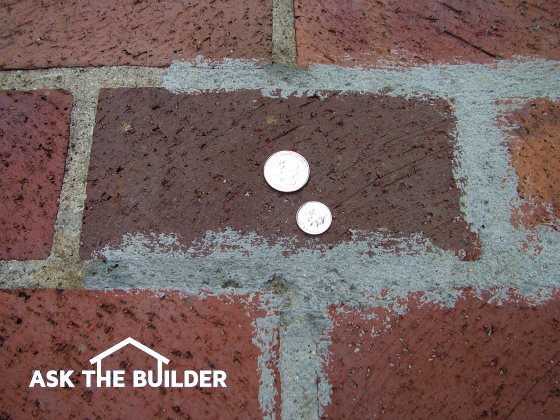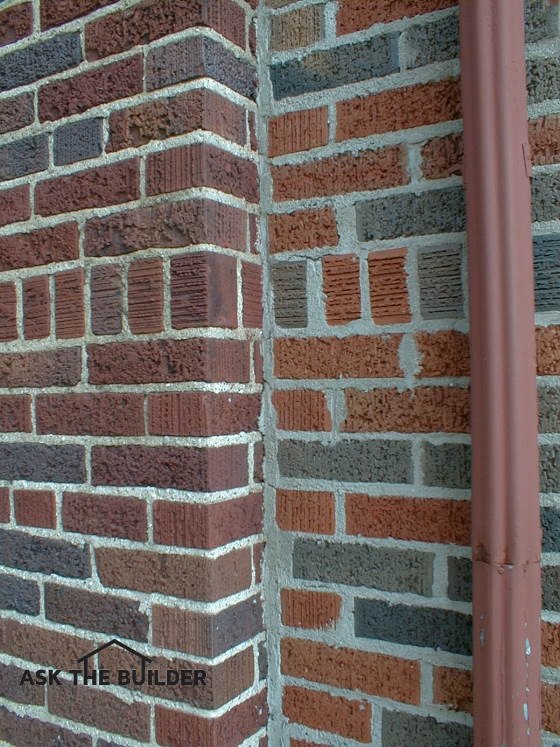Brick Mortar

Brick mortar was smeared onto the brick. It’s been there for over two years to test the strength of the cement in the mortar. The climate is the Midwest USA with harsh winters with lots of freeze/thaw cycles. You can see the mortar is holding on like epoxy. That's a US quarter and a dime on the brick for scale. PHOTO CREDIT: Tim Carter
Brick and Mortar - The Perfect Marriage
DEAR TIM: Brick and mortar and I don’t get along. At my house, the brick & mortar are falling apart. It’s happening on the walls and in a brick patio in my rear yard. I desperately need a brick mortar how-to course so I don’t end up with a huge mess.
What are some of the important steps in brick mortar repair? Are there special tools that make the job go faster and look more professional? Steve T., Morris Chapel, TN
DEAR STEVE: Bricklaying mortar is a fantastic product when you stop and think about it. For all intents and purposes, it’s just glue. You use it to stick two or more things together into one object. You may not believe it, but there’s an enormous amount of science that’s involved in mortar for brick. I can’t begin to scratch the surface in this column.
What is Brick and Mortar?
Bricks are solid rectangular blocks made from fired clay or cast concrete. Mortar is a mixture of sand, Portland cement, and hydrated lime if you're able to find it. The mortar has the consistency of apple sauce and it's used to bind the brick together as one solid unit.

This is a typical installation of brick and mortar in the wall of a house or commercial building. The brick on the right was added years later and it's more orange in color than the brick on the left.
There are many different types of brick mortar, many with different strength properties. A standard mortar used with bricks in a wall often is a mixture of Portland cement, hydrated lime, and some form of clean, washed sand. Note that the sand can have a significant impact on both the strength and final color of the weathered mortar joints. Not all sand looks the same, because the small rock particles that make up the sand are different colors.
How does hydrated lime help mortar?
Many old masonry buildings were made with a mortar that had abundant quantities of hydrated lime or just lime and sand. Typically the more lime that’s in a mortar, the weaker the mortar is. You may think you want a strong mortar, but the lime in the mortar offers a unique self-healing property that may be of great interest to you. If tiny cracks develop in a mortar joint, the hydrated lime can actually grow crystals that seal the crack.
In my opinion, one of the most important steps is to match the mortar to the job. You don’t use the same mortar for your brick walls as you would to patch the mortar joints in your brick patio. The patio mortar needs to be far stronger than the wall mortar as the patio is subjected to more wear and tear, and if you get freezing weather, the mortar must be able to withstand countless freeze-thaw cycles.
David Kullander who hales from Libertyville, Illinois shared this heart-warming story about how he used hydrated lime as a young lad:
"As a 12-13-year-old lad, I labored for my bricklayer dad who belonged to the local mason's union. He made extra money for the family on regular weekend scab jobs for friends and neighbors building garages/fireplaces/additions. I soon was their go-to guy for mixing mortar in a mortar box-trough, using a big hoe with large holes in it. My instructions were 2 shovels of Portland cement, 1 shovel of hydrated lime, 10 shovels of sand, and the needed water to make it the consistency of apple sauce. My dad told me the lime was to make it easier to clean the brickwork when the work was all set and finished. According to him, the muriatic acid solution we brushed the bricks with wouldn't work to get off mortar smears unless the lime was in the mortar to react with the acid. This may be an old wives tale, but who knew- THEY WERE STRENGTHENING THE MORTAR!! Thanks for the article."
AUTHOR'S NOTE: The addition of the hydrated lime did little to aid in cleaning the smears off. Lime makes the mortar stickier, to be honest. It's always smart to add hydrated lime to the mortar mix.
How do you make a strong mortar?
To make a strong mortar for your brick patio, you just use pure Portland cement, sand and water. I would make the mixture very rich meaning that there is lots of cement in the mix. Try a mixture of two parts sand to one part cement.
Be sure you have all loose mortar out of the joint, and that it’s dust-free. Spritz the joint to be repaired with a little water and add the mortar. Make the mortar stand up a little higher than the brick. Wait until the mortar gets a little stiff and then scrape off the excess with a small pointed trowel. If the mortar smears onto the brick, you’re not waiting long enough.
When repairing mortar, check out the existing mortar joints
To repair the mortar in your brick walls, look very carefully at the existing mortar joints. Pay attention to the small colored grains of sand that are visible. When mortar is first installed and it dries, it’s a uniform gray color. This happens because all of the sand is coated with the mortar-cement paste. But over time, Mother Nature erodes the mortar-cement paste from the sand exposing the different pieces of small rock that make up the sand. You may see brown, red, gray, white, and even green pieces of sand!
You'd do well to read my repairing brick mortar column for additional information.
The trick is to visit a local sandpit and look at the different sands. Note that there can be a difference in both grain size and color. You want to match both as closely as possible. This will be well worth the effort if you intend to restore your brick walls so the repairs match the original work.
You can purchase bags of premixed brick mortar from a business that sells building supplies. Avoid the home centers as they usually will not have a selection of different mortars. You want to match the color of the mortar as well as the strength. The older your home remember that you want a mortar that is weaker.
Get FREE BIDS from local bricklayers to repair your brick and mortar.
Are special tools needed to work with mortar?
You don’t need too many special tools when working with brick mortar. I find that a medium pointed trowel, a small pointed trowel, a narrow pointing trowel that’s only as wide as the width of the mortar joint, and possibly a mortar grouting bag will commonly allow you to do most repairs. You may need a mortar chisel to help you remove crumbling mortar from between brick.
It’s really important to make sure the brick joints are clean, dust-free, and damp before you add the new mortar. The water that you spritz on the brick and old mortar helps make your new mortar that much stronger. Without the spritzed water, the dry brick and old mortar will suck out the water from the mortar too quickly. If this happens, the new mortar will never get as strong as it could be.
Take your time to avoid smearing the mortar on the brick face. If you do make mistakes, try to scrape off as much excess mortar as you can that day. Then wait 30 days before you attempt to clean the mortar paste from the brick. Use a solution of muriatic acid and water mixing one part acid to ten parts water. Dampen the brick to be cleaned with water and add the acid solution. Wear rubber gloves, goggles and old clothes. The acid is very toxic. Allow it to sit and fizzle on the mortar pastes, then scrub the area with a scrub brush after ten minutes. Rinse with plenty of water. Repeat if necessary until all mortar paste is removed from the brick.
This column was mentioned in my January 5, 2017 AsktheBuilder Newsletter.
Column 784
21 Responses to Brick Mortar